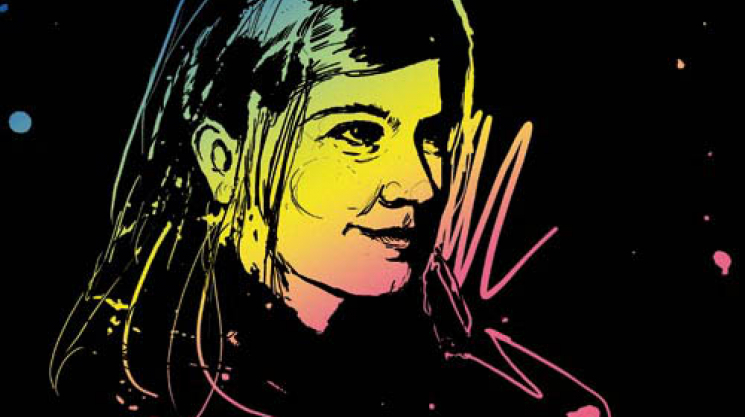
Tue, 09/01/2009 - 00:00 by AltaGrade
She answers the phone with a chirp and a lie. “This is Sally!” she says, in that cheery Swedish accent that suddenly makes the air brisk and the daylight blonde. But Sally isn’t her name. Not right now, at least. Sally Shapiro is the moniker she uses when she becomes the Italo disco princess that released 2006’s Disco Romance, an album of equal parts dreamy and dancey Eighties-inspired pop tunes. On the phone, she is but a humble office worker in the Swedish town of Lund (she’s never divulged her real name). For the last year, Sally (for lack of a better name) has been furtively working on her second album, My Guilty Pleasure, and slowly narrowing the gap between the woman she is on the album and the woman she is now on the phone.
Sally Shapiro began as a calculated throwback to Europe’s disco scene in the early Eighties, when “Valerie Dole” rose to fame, a fabricated identity with the eccentric style of Italian model Monica Stucchi and the voice Dora Carofiglio. (she reappeared in the mid-Eighties entirely under Stucchi’s voice and image.) But the homage didn’t end with alias. Even Disco Romance’s cover art was purposefully (and painfully) Eighties, with stark colours, cartoon stars and Sally Shapiro’s name stamped in a stripped down Circus Circus font. From top to bottom, Sally Shapiro was an Italo disco revival act. In on the joke, but serious about the material, she was lauded for mining deeply into an old, underground genre. But the question remained of whether she could strike gold again with My Guilty Pleasure.
“I really like this album! When we made the first album, we wanted everything to be in the Eighties. Now we’re free to take from other styles,” Sally says from the apartment of her friend and producer Johan Agebjörn. Agebjörn normally produces ambient electronic tracks, while Sally’s tastes skew towards bubbly indie pop. Both sounds—along with a little house, maybe a touch of R&B—pervade throughout the otherwise longing and spacey Italo disco trademark to become something both nostalgic and new. “The album is a mix of our tastes,” says Sally. In fact, Agebjörn and his ingénue are two colliding circles of a Venn diagram, and from where they meet sprang Sally Shapiro.
The two met in 2001 doing administrative work in an “ordinary office.” (“Ordinary” is a word that Sally uses a lot. She has an ordinary job, in an ordinary office. Nothing like the extraordinary, otherworldly dreamscape of her albums.) For years they had a quiet, if not professional, rapport until they began exchanging mix tapes, spurred by some long-forgotten debate. “I know I started it,” says Sally, “but I don’t really know why!” Agebjörn was surprised to find Italo disco tracks in the mix, but it was something Shapiro had grown up listening to. “It was the thing they always played on the radio and I listened lots to the radio,” she says, “I sat down and taped everything on those listens.”
It was Christmastime when Agebjörn first heard Sally’s singing voice. Together with a few friends and neighbours, the group sang Christmas carols around a piano. (“Because it’s fun!” says Sally. “Because it’s Christmas!”) Agebjörn noticed that Sally had the soft and sentimental voice of Italo disco stars Dore and Katy Gray, something she had developed singing in childhood choirs. “But he didn’t tell me,” says Sally. “Later, when he had written ‘I’ll Be By Your Side,’ he asked me to sing on it.”
The two had no intention of releasing the song, which eventually became Disco Romance’s opening track, until Agebjörn posted it online and found an overwhelmingly positive response. “The first album was so unexpected,” says Sally, “since we wrote one track, and people liked it. Then we wrote some others and it became an album.” If the story sounds reductive, or “ordinary,” perhaps it’s because of Sally’s pressure-shy modesty. Though the project began as a group sing-along, neither Agebjörn nor any of Sally’s fans have seen her sing the songs from her repertoire. “It’s okay singing Christmas carols just for fun,” she says. “It doesn’t have to sound so good.” Agebjörn has never even seen her record their tracks, which she does in his apartment studio—after kicking him out. “He just leaves the apartment,” she says with a lilting laugh, “It’s better than just in the other room.” (The only time Agebjörn ever broke Sally’s proviso ended with a tongue-lashing that the two still laugh about. “It’s a pretty nice recording. I still have it,” says Shapiro between peppered chuckles, “I sound so hurt! I stopped singing and yelled, “You shouldn’t be here! Why are you in here?!’”)
Though Sally has never sung live, she and Agebjörn performed a series of DJ sets earlier this year—something she is not keen to repeat. “I don’t really like that lifestyle of touring around,” she says, “I want to have a home and to be there.” Still, the sets gave her the first opportunity to meet some of her fans, and come to some revelations. “It was nice to meet the fans and to realize that they are just normal, nice people—and not scary!” She laughs. “It was a surprise. It shouldn’t be, but it was.”
That Sally Shapiro exists in the Italo disco tradition of dual identities is at its very least, fortuitous. With two full-lengths (and two more remix albums in between) full of lovelorn pop songs and post-party wistfulness, it’s easier for the listener to follow the mythical woman and her many loves without expecting Sally herself to be a Dancing Queen. But with the second album and growing fame, more people in Sally’s first life have uncovered her second. “I haven’t told them, ‘You can’t say Sally is me,’” she says, “Everybody just thinks it’s funny, so they don’t say anything. But maybe it will come out eventually.”




Add comment